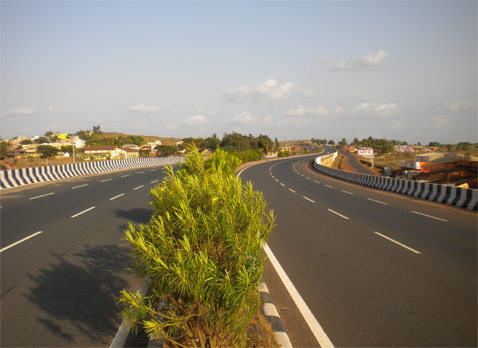
Ashoka Buildcon
Since Ashoka Buildcon started its journey in highway development in 1996, much has changed. How has the road and bridge sector evolved since then?
When Ashoka entered into the infrastructure development sector, India was struggling to improve its quality of highway infrastructure. Many important locations in the country awaited adequate road connectivity. Existing highways were infamous for their pot holes and poor safety standards. Both the state and central government were short on funds to address such a huge requirement.
During the 1990s the government initiated the PPP based highways development model. This would rope in private funds for construction of highways on Build Operate and Transfer Basis. The concept did not receive a welcoming response and private companies were reluctant to invest in such projects.
Ashoka Buildcon Ltd. was one of the very few enterprises to venture into test their mettle in BOT sector. Dhule Bypass was its first project in Maharashtra. The project was successfully completed and this set the ball rolling for Ashoka to keep surging ahead in the sector.
Such projects started gaining popularity. It was beginning to prove as a win-win situation for every one. Private funds were now being used for the development of nation’s infrastructure which meant that the government could mobilise its treasury for other development activities. The private companies introduced newer technologies and expertise in road construction. Highways and expressways paved the road for progress enhancing commercial as well as non commercial transportation. Concessionaires are responsible for maintaining the road throughout their concession period and also for the various safety measures that have to be implemented on the project.
Where should you position Ashoka Buildcon in the current infrastructure market?
Ashoka Buildcon is amongst the pioneers in BOT based highway projects in the country. With a portfolio of over 28 BOT projects, which is the largest in number by any private player in India, Ashoka stands amongst the top players in the sector. With some of our project having completed their concession period and subsequently handed over back the government, we are a company that has experienced the complete life cycle of a BOT Project.
We are not only developing highways and bridge, but are also adding value to the industry.
Ashoka Highway Research Centre is our research wing that focuses on exploring newer and better ways of building highways such that they can be safer, eco-friendly, cost effective and longer lasting.
Ashoka Buildcon is one of the first Indian infrastructure company in India to be certified by ISC Pty. Australia for Integrated Management System comprising of Quality, Environmental and Safety Standards.
At 4.7 million km, India has the second largest road network in the world. How big can India’s road network grow from here in the next 5 years?
India’s transportation needs are extensive. Although the aviation industry is gaining more and more acceptance, travel and transportation by rail and road still remains a preferred option by the majority. Roads are always on the priority list of any government because it is a basic necessity for the progress of any city, town or village. Despite a large road network already in place, there is still a lot more that needs to be done. Even today innumerable inhabited areas are deprived of basic road connectivity. I am confident that the coming five years will see tremendous growth and development in this sector.
The Indian government plans to develop a total of 66,117 km of roads under different programmes and has set an objective of building 30 km of road a day from 2016. How should the government address to achieve the goal?
Our country seriously needs to revisit its bureaucratic setup. To achieve such ambitious targets the entire sector needs to be put on a fast-forward mode with respect to approvals, settlement of disputes and other major issues which require government intervention.
Land acquisition, requisite approvals and uncertainties with regards to escalation in prices of raw material, manpower and other resources continue to hamper the strengthening of this industry.
We also feel that the new land acquisition act is going to be a challenge for the government because it may lead to increase in land prices without addressing the issue of dispute resolutions and time for acquisitions.
India’s rapid growth in the recent years has proved that infrastructural strength is the primary ingredient for development of any country. We are positive on the fact that the governments at the Central as well as state level will soon establish a body that will focus on settling matters that delay the completion of the project.
Ashoka Buildcon has an impressive portfolio of over 28 PPP projects. Why does PPP matter and what’s its future?
Public Private Partnership, or PPP model, as the name suggests is a joint effort by the private enterprises and the government agency in creating better infrastructure for the citizens. This project enables private funds to be utilized for the purpose of national development. It addresses not just the issue of financial resources but also opens doors to technological advancement and technical expertise being deployed in the construction of the projects.
We are also hopeful that the public private partnerships will find new avenues in annuity-based projects which are likely to be the future of infrastructure development. We also look forward to projects that will empower the developer with land development rights that can ease the burden on toll based road projects.
What comes to your mind as your most challenging or interesting projects?
All our projects have been unique and special in their own way. Recently we built two parallel bridges across river Roopnarayan in West Bengal. The project was so challenging that for over 10 years no construction company was coming forward to complete the same. Earlier, one company which had tried to build the bridge across, abandoned the construction midway due to the seemingly insurmountable geographical and technical difficulties. Ashoka rose to the challenge and not only completed the partially construction bridge, it built another one parallel to it. Both these bridges were completed in 12 months, which was 18 months ahead of schedule.
Another major highlight of the project was the fact that for the first time in bridge construction, we built a bridge by launching a 323m long steel girder assembly weighting over 1,700 tonnes.
In the past too, we have set various milestones. These include the construction of a bridge in 38 days against an allotted time of 12 months—a Limca Book record). We constructed Indore Edlabad highway, which was then the largest BOT-based highway project awarded to a private player in India. The Phalodi to Pachpadra highway in Rajasthan was built 90 days ahead of schedule despite extreme weather conditions. The list goes on.












